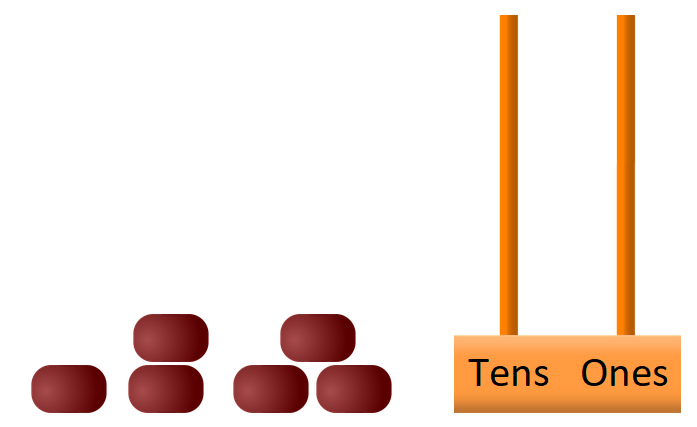6 beads
If you put three beads onto a tens/ones abacus you can make the numbers 3, 30, 12 or 21. What numbers can be made with six beads?
Problem
If you put three beads onto a tens and ones abacus you can make the numbers 3, 30, 12 or 21.

Explore the numbers you can make using six beads.

Can you find all the ways of using six beads?
How do you know you have found them all?
If you would like to try another task which involves finding all possible solutions, you could look at Three Ball Line Up.
Getting Started
It might help to use some equipment e.g. counters, beads, pebbles etc.
How will you know you have found all the different ways?
Student Solutions
We had over 60 correct answers to this challenge. Here are just some of them that also say a bit about what they did.
Nicholas from Congleton wrote:
P.S.: I wrote down the answers on a jotter as I went along.
Emily from Mount School wrote:
I noticed that with three beads you made four numbers and with six beads I made seven numbers so I tried it with four beads and made five numbers, always one more number than beads.
Sam from Comberton wrote:
We had the following splendid picture and notes from a key Stage 2 teacher at Ysgol Aberdyfi in Wales.

Teachers' Resources
Why do this problem?
Possible approach
You could start the children off by showing them one of the examples for three beads and then asking for other ways the beads could be arranged, reading the numbers together. You may want to use a basic drawing of the abacus on an interactive whiteboard and have 'beads' to drag into place. At this stage, you could encourage learners to try and explain how we know we have all the different ways.
After this the children could work in pairs on the six beads problem so that they are able to talk through their ideas with a partner. Have available a range of equipment which they could use, but allow them to make their own choice. You may have, for example, a real abacus, counters, paper, beads, coloured pencils/pens etc. They could use digit cards to make the number which is represented on the abacus.
In a mini plenary, children could compare the ways in which they are beginning to record their findings and you could discuss the advantages of each. You could then talk about which recording methods might be best if we want to be sure that we had all the ways of using six beads. At this point, you could give them more time to work on the task, particularly enouraging them to consider how they will know that they have found all the solutions. You may find that some pairs change their recording method.
As you move around the room, ask some pairs to record one of their solutions on an abacus that you have pre-drawn. In the plenary, stick up those individual solutions on the board or wall and encourage the whole group to work together to make sure they have found all possibilities. Invite learners to reorder the solutions to reflect a pattern and use this to create any solutions that are not yet displayed. Emphasise that although they have worked together using one pattern, or one particular way of working systematically, there is no 'right' way to work systematically. There will be many different systems in the room and that should be celebrated.
Key questions
Possible support
Some children may find it easier to use four beads, rather than going straight on to six. Using practical apparatus, such as counters, is essential for those having difficulties in understanding the problem. Learners could record individual solutions on individual pieces of paper, which could then be moved around and ordered to help them create a system.
Possible extension
Learners could increase the number of beads or they could be asked to investigate what would happen if there were three columns: units, tens and hundreds. If learners would like another context in which to practise working systematically, Three Ball Line Up would be an appropriate task.

